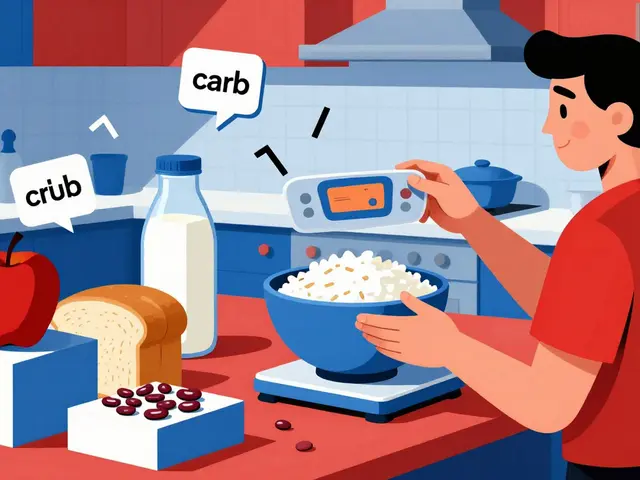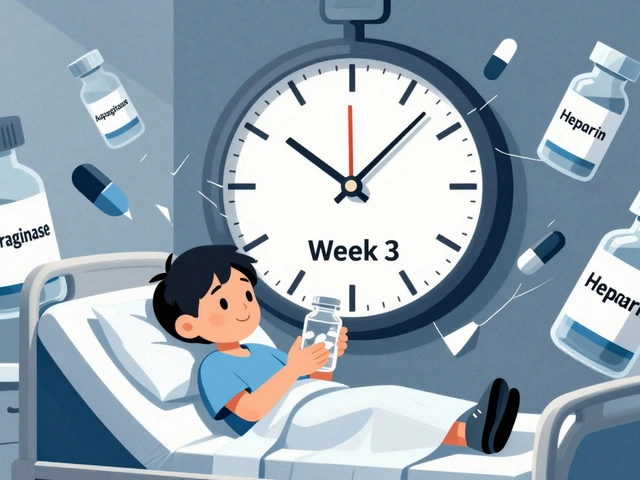
NSAID Comparison & Selection Guide
Select Your Needs
Recommended NSAID Options
Detailed Comparison Table
| Drug | Dosing | GI Risk | Cardio Risk | Cost |
|---|
Key Takeaways
- Diclofenac SR offers consistent pain relief but carries notable gastrointestinal and cardiovascular risks.
- Ibuprofen and naproxen are well‑trusted over‑the‑counter options with shorter half‑lives.
- Celecoxib and etoricoxib are COX‑2‑selective drugs that lower GI risk but can raise heart‑related concerns.
- Meloxicam provides a middle ground with once‑daily dosing and moderate safety profile.
- Choosing the right NSAID depends on dosage convenience, risk tolerance, cost, and the specific condition being treated.
When you look at a shelf of painkillers, the sheer number of choices can feel overwhelming. Most people end up grabbing whatever they’ve seen in the pharmacy aisle, but not every NSAID suits every situation. Below we break down Diclofenac SR and line it up against the most common alternatives so you can decide which one actually fits your needs.
Diclofenac SR is a sustained‑release formulation of the non‑steroidal anti‑inflammatory drug (NSAID) diclofenac. It works by inhibiting cyclooxygenase enzymes (COX‑1 and COX‑2), which reduces prostaglandin production and therefore lessens inflammation and pain. The “SR” (sustained release) design releases the drug slowly over 12‑24hours, making it handy for chronic conditions like osteoarthritis or rheumatoid arthritis.
How Diclofenac SR Stacks Up
The biggest advantages of Diclofenac SR are its once‑or‑twice‑daily dosing and its proven efficacy for joint pain. However, it also carries a higher risk of gastrointestinal (GI) bleeding and a noted increase in cardiovascular events compared with some newer NSAIDs. Pricing varies: generic versions typically cost around $15‑$25 for a 30‑day supply in the US (2025). Below is a quick snapshot of its core attributes.
| Attribute | Value |
|---|---|
| Form | Sustained‑release tablet |
| Typical dose | 50mg twice daily |
| Half‑life | 1-2hours (but SR extends effect) |
| Onset | 1-2hours |
| Common uses | Osteoarthritis, rheumatoid arthritis, acute musculoskeletal pain |
| GI risk | High (especially without protective PPI) |
| Cardiovascular risk | Elevated |
| Average monthly cost (generic) | $15-$25 |
Popular Alternatives to Consider
Below are seven other NSAIDs that frequently appear as alternatives. Each entry includes a brief definition with microdata so search engines can recognize the entities.
Ibuprofen is an over‑the‑counter (OTC) NSAID that blocks COX‑1 and COX‑2, offering pain relief for headaches, dental pain, and mild to moderate inflammation.
Naproxen is a longer‑acting OTC NSAID often used for menstrual cramps, arthritis, and sports injuries; its half‑life lets it be taken twice daily.
Celecoxib is a prescription COX‑2‑selective NSAID designed to spare the stomach lining, making it a go‑to for patients with GI concerns.
Etoricoxib is another COX‑2‑selective agent, approved in many countries for osteoarthritis and acute gout; it’s not FDA‑approved in the US yet.
Meloxicam provides a middle ground with once‑daily dosing and moderate COX‑2 selectivity, commonly prescribed for chronic arthritis.
Aspirin is a classic NSAID that irreversibly inhibits COX‑1, often used for low‑dose cardiovascular protection but also for pain and fever.
Ketorolac is a potent short‑term injectable or oral NSAID used in hospital settings for severe postoperative pain; it’s limited to five days because of toxicity risk.
Side‑by‑Side Comparison
| Drug | Form | Typical Dose | Half‑Life | Onset | GI Risk | Cardio Risk | Cost / month (USD) |
|---|---|---|---|---|---|---|---|
| Diclofenac SR | Sustained‑release tablet | 50mg BID | 1-2h (extended effect) | 1-2h | High | Elevated | $15‑$25 |
| Ibuprofen | Immediate‑release tablet | 200‑400mg Q4‑6h | 2-4h | 30‑60min | Moderate | Low‑moderate | $5‑$10 |
| Naproxen | Immediate‑release tablet | 250‑500mg BID | 12‑17h | 1‑2h | Moderate | Low‑moderate | $8‑$12 |
| Celecoxib | Extended‑release capsule | 200mg QD | 11h | 1‑2h | Low | Higher (especially in >65y) | $30‑$45 |
| Etoricoxib | Immediate‑release tablet | 60‑120mg QD | 22h | 1‑2h | Low | Higher (thrombotic events) | $35‑$50 |
| Meloxicam | Extended‑release tablet | 7.5mg QD | 15-20h | 1‑2h | Moderate‑low | Moderate | $12‑$20 |
| Aspirin (81mg) | Enteric‑coated tablet | 81mg QD | 3-7h | 30‑60min | Low (low dose) | Protective (low dose) | $3‑$6 |
| Ketorolac | Oral tablet / injectable | 10‑20mg Q6‑8h (max 5days) | 5-6h | 15‑30min | High | High | $20‑$30 (short term) |
When to Choose Diclofenac SR
Diclofenac SR shines in scenarios where you need steady pain control over a full day without multiple pills. Typical use‑cases include:
- Chronic knee or hip osteoarthritis where daily dosing improves adherence.
- Rheumatoid arthritis flares that require consistent anti‑inflammatory effect.
- Post‑operative pain that persists for several days, provided the patient has no ulcer history.
If you have a history of stomach ulcers, recent heart attack, or are on anticoagulants, you should steer clear or pair the drug with a proton‑pump inhibitor (PPI) under doctor supervision.
When Another NSAID Might Be Better
Here’s a quick decision guide based on common concerns:
- Short‑term, mild pain (headache, toothache): Ibuprofen or naproxen are cheap, fast‑acting, and have a lower risk profile for short courses.
- GI‑sensitive patients: COX‑2‑selective drugs like celecoxib or etoricoxib reduce stomach irritation, though you must watch cardiovascular health.
- Once‑daily convenience without high cost: Meloxicam offers daily dosing and moderate safety at a lower price than many COX‑2‑selectives.
- Need for rapid, strong analgesia in hospital: Ketorolac works within minutes but is limited to five days due to kidney and bleeding risk.

Cost Considerations in 2025
Drug prices have risen modestly over the last year. Generic diclofenac SR remains among the cheaper prescription NSAIDs, yet it still costs more than common OTC options. If you’re on a tight budget, start with ibuprofen (often $5 for a pack of 100) and only move to prescription‑only diclofenac if OTCs fail to control your pain.
Practical Tips for Safe NSAID Use
- Always take NSAIDs with food or milk to protect the stomach lining.
- Limit use to the lowest effective dose for the shortest duration needed.
- If you need an NSAID longer than a week, discuss a protective PPI (e.g., omeprazole) with your clinician.
- Check for drug interactions: avoid combining multiple NSAIDs, watch for blood thinners (warfarin, clopidogrel), and be cautious with antihypertensives.
- Monitor for red flags: sudden stomach pain, black stools, unexplained swelling, or chest discomfort should trigger a doctor call.
Frequently Asked Questions
Is Diclofenac SR safe for long‑term use?
Long‑term use can be appropriate for chronic arthritis, but doctors usually pair it with a gastro‑protective agent and monitor heart health. Regular labs and symptom checks are recommended.
Can I take Diclofenac SR together with ibuprofen?
No. Combining two NSAIDs adds unnecessary GI and kidney risk without improving pain relief. Choose one or discuss a different class with your doctor.
What makes COX‑2‑selective NSAIDs different?
COX‑2‑selective drugs (celecoxib, etoricoxib) block the enzyme mainly involved in inflammation while sparing COX‑1, which protects the stomach lining. This lowers GI side effects but can increase cardiovascular events in susceptible patients.
Is it okay to use Diclofenac SR while on aspirin for heart protection?
Mixing them raises bleeding risk because both affect platelets and the stomach. If you need both, your physician may adjust doses or suggest an alternative NSAID with lower bleeding potential.
Which NSAID is best for people with kidney disease?
All NSAIDs can affect kidney function, but the risk is highest with strong agents like diclofenac and ketorolac. Low‑dose ibuprofen under close monitoring is often preferred, though many clinicians avoid NSAIDs altogether in moderate‑to‑severe kidney disease.
Ultimately, no single NSAID fits every case. By weighing dosing frequency, side‑effect profile, cost, and your personal health history, you can pick the drug that delivers relief without unwanted complications. Talk to your healthcare provider with this comparison in hand-they’ll help you tailor the choice to your exact situation.








17 Comments
American pharmacies stock the best NSAIDs and we don’t need imported pills that claim to be safer.
I can’t believe anyone still uses diclofenac when there’s better options 😒
Diclofenac’s dual COX‑1/COX‑2 inhibition delivers robust analgesia, yet its heightened gastrointestinal toxicity stems from COX‑1 suppression of protective prostaglandins. In contrast, ibuprofen’s shorter half‑life yields a more favorable safety window for intermittent use. Naproxen’s prolonged half‑life offers convenience but does not mitigate its moderate GI risk. The COX‑2‑selective agents, celecoxib and etoricoxib, spare the stomach lining at the expense of a paradoxical cardiovascular signal seen in meta‑analyses. Meloxicam straddles the line with modest COX‑2 selectivity and once‑daily dosing, making it a pragmatic compromise for chronic arthritic pain. Aspirin at low dose is cardioprotective but offers negligible anti‑inflammatory effect. Ketorolac remains a hospital‑only, short‑term powerhouse with a steep bleeding profile that precludes outpatient use. Cost considerations also shape choice: generic diclofenac hovers near $20/month, whereas ibuprofen is often sub‑$5 for a bulk bottle. Ultimately, clinicians must weigh the pharmacodynamic profile against patient‑specific comorbidities.
Wow, that table is a lot to take in, but honestly I just grab whatever’s on sale. If my stomach feels weird I’ll pop a antacid, otherwise I stick with what works for my knee.
When one surveys the landscape of non‑steroidal anti‑inflammatory agents, one cannot help but be struck by the stark dichotomy between efficacy and peril. Diclofenac, with its sustained‑release formulation, offers a commendable constancy of plasma concentration, thereby smoothing the peaks and valleys of pain that plague chronic arthritic patients. Yet this very constancy is a double‑edged sword; the relentless inhibition of COX‑1 hammers the gastric mucosa, ushering in a cascade of ulcerogenic potential that no clinician may cavalierly disregard. Moreover, the cardiovascular shadow that looms over diclofenac, as illuminated by recent meta‑analyses, demands a vigilant appraisal of the patient’s cardiac risk profile before any prescription is penned. In juxtaposition, ibuprofen presents a more transient pharmacokinetic footprint, granting clinicians a modicum of flexibility in titrating dose and timing, albeit at the price of modestly reduced anti‑inflammatory vigor. Naproxen, with its prolonged half‑life, bridges the chasm between the two, offering the convenience of once‑ or twice‑daily dosing while maintaining a tolerable safety spectrum for many. COX‑2‑selective agents, such as celecoxib and etoricoxib, promise a sanctuary for the gastro‑intolerant, sparing the stomach lining from the ravages of COX‑1 blockade; however, their whispered promise of cardiovascular safety is, paradoxically, a siren song that may culminate in heightened thrombotic events, particularly in the elderly or those bearing a burden of atherosclerotic disease. Meloxicam, perched delicately between selectivity and convenience, emerges as a compromise, delivering daily dosing with a tolerable GI profile, yet it is not immune to the specter of renal compromise in susceptible individuals. Aspirin, the venerable ancestorial antiplatelet, at low doses, confers cardioprotection, but its anti‑inflammatory potency is a faint echo, insufficient for the rigors of arthritis management. Lastly, ketorolac, the heavyweight champion of short‑term analgesia, is wielded with caution, its therapeutic window limited to five days to avert the twin perils of gastrointestinal bleeding and renal dysfunction. In the final analysis, the optimal NSAID is not a monolithic entity but a tailored selection, calibrated to the individual’s comorbid tapestry, financial considerations, and the mercurial nature of pain itself. The clinician’s role, therefore, is not merely to dispense a pill but to orchestrate a nuanced symphony of risk‑benefit calculus, ensuring that relief is achieved without ushering in a cascade of iatrogenic calamities.
One must ask whether prescribing a drug that endangers the stomach is morally defensible without ensuring protective measures
Sure diclofenac works but the hype is overblown its side effects are real
Don’t worry you’ll find a safe option – keep an eye on how you feel and talk to your doc 😊
I think the table is defnitely helpful but maybe add a column for drug interactions you know?
Oh great another exhaustive chart, because we all have time to read tables while waiting for the nurse.
Actually, the COX‑2 selectivity of celecoxib isn’t as high as some claim; the risk profile is more nuanced than the table suggests.
Just a quick note – I’ve been on ibuprofen for a week and my stomach feels fine.
We should trust our own meds not some foreign guidelines Americans know best
Ah the moralist raises a point, but let’s remember the patient’s autonomy is also a sacred principle – sarcasm aside.
Everyone seems polarized – perhaps we can agree on a shared decision model that respects efficacy, safety, and cost?
Excellent summary! However, I would suggest adding references to the primary literature for verification; it's crucial for thorough understanding.
Tip: If you’re on a daily NSAID, consider a periodic check of kidney function and blood pressure.